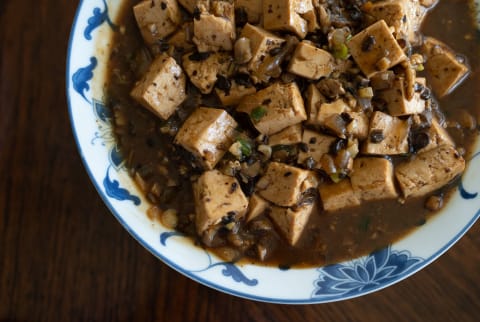I’m here thanks to my old friend Bradley Willcox, who, along with his brother, Craig, and economist Makoto Suzuki, authored The Okinawa Program. Willcox is currently a professor and director of research at the Department of Geriatric Medicine at the University of Hawaii at Manoa. When I asked him to introduce me to an older Chinese American woman who might be willing to cook with me, he instantly replied, “Ruth is the one. I’ll join you.” Ruth shuttles food from the kitchen to a lazy Susan on her dining room table with a Chihuahua’s energy and a ballerina’s grace. Steaming, delicious-smelling platters of Savory Garlic Tofu With Minced Mushrooms (recipe below) and Veggie Noodle Stir-Fry arrive. Craig, David, my dad, and I look on hungrily. “This food has maybe a fifth the caloric density of a hamburger and 10 times the nutrients,” Craig says, rotating the garlic tofu in his direction. “So you can eat to your stomach’s content and never gain weight.” By 1830, Chinese immigrants began arriving in Hawaii as contract agricultural laborers (and later in the continental United States largely to work in gold mines). Japanese and Korean immigrants came later, and in the early 20th century, so did Filipinos. Each group brought their own dishes and ingredients with them. The Chinese brought leafy cabbage, soybean products, and teas. The Japanese contributed miso and their own version of tofu. Filipinos introduced seaweed (for umami) and tender tips of plants such as squash, pumpkin, cowpeas, and sweet potato vines, which they add to stews. Meanwhile, Krishnendu Ray, a food studies scholar at New York University and the author of The Migrant’s Table, tells me that immigrants from central Europe brought their cows, pigs, and pickles. “It was Asian immigrants who taught Americans how to eat greens,” he says. “In their countries, they couldn’t afford meat, so they learned how to make vegetables taste good, largely through cooking technique and use of herbs.” East Asians have immigrated to the United States for more than 250 years, and the U.S. experienced enormous Southeast Asian migrations in the late 20th century. Only a handful of dietary studies were recorded before World War II. Between 1896 and 1903, the University of California, Berkeley, professor Myer Edward Jaffa and his students studied the food consumption of 10 Chinese laundry workers, a dozen fieldworkers, and a dentist’s family living in and around San Francisco. He found their diets consisted largely of rice, noodles, and tofu. The laundry workers consumed yams, wheat bread, sprouts, mustard greens, dried fungus, and water chestnuts. Though their hard labor had them consuming more than 4,200 calories daily, less than 25% of those calories came from animal products, and only 5.5% came from sugar. Today, Hawaii is arguably the best place in America to experience Asian fusion cuisine. Many traditional Asian herbs and vegetables thrive in the fertile soil and mild climate of Hawaii. And throughout the island state, plantation systems—where several ethnicities shared a communal kitchen—became de facto fusion laboratories that have influenced the cuisine of today. Serve this vegetarian dish over rice with a dash of chilies in vinegar on the side. He is the author of The Blue Zones series of books: The Blue Zones: Lessons for Living Longer from the People Who’ve Lived the Longest, Thrive: Finding Happiness the Blue Zones Way, The Blue Zones Solution: Eating and Living Like the World’s Healthiest People and The Blue Zones of Happiness, The Blue Zones Kitchen, The Blue Zones Challenge & The Blue Zones American Kitchen. Buettner also holds three Guinness Book of world records in distance cycling.



